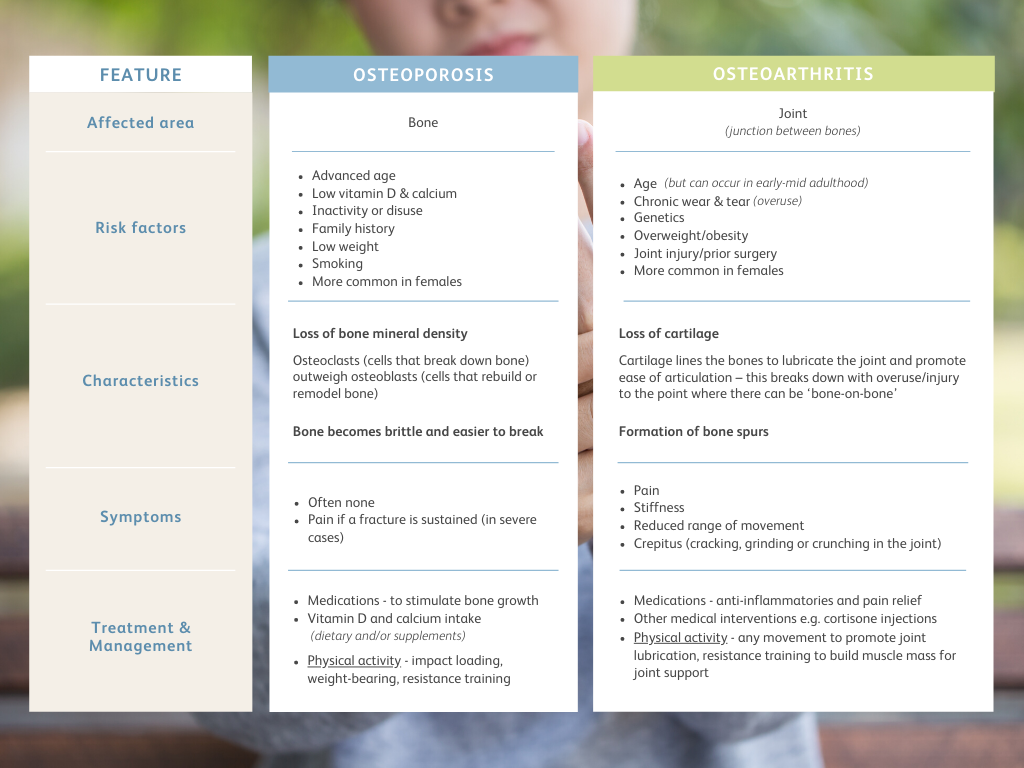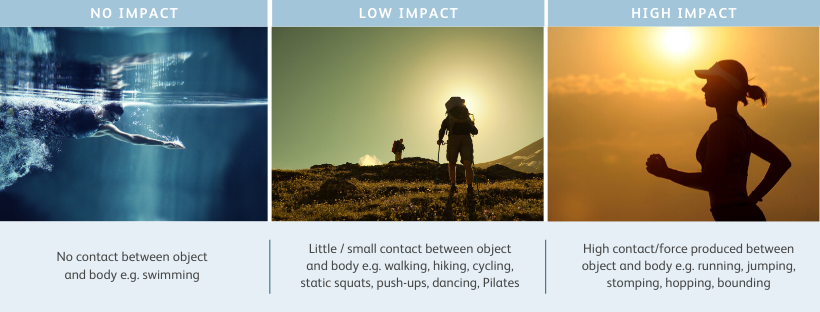
Sophie Pacek
Exercise Physiologist, Healthy Connections
One of my relatives was recently diagnosed with osteoporosis, an age-related condition where our bones lose their density and become brittle over time leading to an increased risk of breakage. My relative was surprised at the diagnosis because she hadn’t experienced any pain; however, contrary to common belief, osteoporosis often presents with no symptoms. As for treatment, my relative has been recommended to keep walking.
While walking has many benefits (like increasing fitness, assisting with weight loss, improving heart and lung health, and enhancing mental wellbeing), it has not been shown to be significantly effective in delaying further losses in bone density in those with osteoporosis (Beck et al., 2017). What is recommended is a combination of weight-bearing impact exercise and resistance training. Let’s explore further!
“My friend said she has ‘osteo’ and gets pain…. Is that osteoporosis?”
Despite their similar names, osteoporosis and osteoarthritis are very different in nature. Your friend could have either, or even both, but it is important that individuals are well informed about their conditions and how to manage them.
The prefix of ‘osteo’ means ‘bone’, so both conditions involve bone in some way. ‘Porosis’ means ‘the process of becoming porous’, so osteoporosis refers to porous or brittle bone. On the other hand, ‘arthritis’ means joint (‘arthr’) inflammation (‘itis’), so osteoarthritis is a condition whereby a joint (junction between bones) is inflamed (Hunter & Eckstein, 2009). Below are some other distinguishing features between these conditions.

(click on image to enlarge)
In summary, osteoporosis and osteoarthritis differ in symptoms, physiology and management strategies.
What is impact exercise?
Our body’s cells are constantly remodelling – breaking down / destroying old cells and replacing with new ones. This includes our bone cells. Osteoclasts are bone cells that break down and destroy old bone while osteoblasts create new bone (Ehrman et al., 2013). In someone with normal bone mineral density, there is a balance between the actions of osteoclasts and osteoblasts to ensure bones remain strong. In osteoporosis, there is a mismatch in this balance, where the breakdown of bone is occurring at a greater rate than the remodelling. So how do we combat that? Through stimulating the action of osteoblasts.
One way to do this is through impact loading exercise. This type of activity involves one object coming into contact with another. For example, jumping involves our body coming into contact with the ground. This connection causes a ground reaction force whereby the ground exerts a force on our body as a response to our contact with it (Kelley, Kelley & Kohrt, 2013). The size of the ground reaction force is dependent on the level of impact – lower impact activities produce less force than higher impact movements. Regardless, each impact ‘stresses’ our bones, which causes them to regenerate stronger so that they are able to cope with this impact when it next arises.
Exercise can have no, low or high levels of impact.

What is better?
Each level of impact has its benefits depending on your exercise goals, level of fitness and whether you have any injuries/conditions. Generally, a combination is recommended but it is based upon what is appropriate for the individual.
High impact exercise leads to faster improvements in your fitness and strength but is harder on your body; lower impact exercise is easier on the body but improvements come at a slower rate.
What is suitable for me?
High impact is suitable for:
- Wanting a challenge – high impact exercise typically is more intense
- Building bone strength – bones need to be stressed to stimulate growth
- Individuals at a low risk of injury – high impact is harder on the body which if not performed appropriately, could result in injury
Low impact is suitable for:
- Individuals who are injured or recovering from injury – low impact is great for maintaining fitness and strength whilst avoiding reinjury
- Giving your joints a break – high levels of high impact activity may place too much stress on the body so having a break by doing some low impact workouts is recommended to avoid injury
- Improving technique and balance – low impact workouts typically focus more on strength, posture, body awareness and balance
- Beginners to exercise – it is important to learn technique and perform controlled movements before progressing to faster, powerful and more intense activities
Note: The level of impact is based upon the individual’s current activity routine – for someone who is relatively sedentary and walks occasionally, ‘high impact’ for them will be different to someone who runs daily or plays a sport involving jumping.
Level of impact for osteoporosis
Guidelines exist for what exercise is safe and appropriate for individuals who have reduced bone mineral density (Beck et al., 2017). These recommendations are evidence-based (i.e. based upon extensive research evidence) and guide our exercise physiologists at Healthy Connections in prescribing exercise for this population.

Level of impact for osteoarthritis
In general, individuals with osteoarthritis are recommended to perform low impact aerobic exercise to reap the benefits of physical activity whilst managing pain and reducing the risk of further damage to joints (Hunter & Eckstein, 2009). Furthermore, resistance training to strengthen supportive muscles around the affected joint are recommended to improve joint range of movement and function. Long-term participation in high impact exercise increases the risk of further injury so are generally discouraged in large amounts (Hunter & Eckstein, 2009). Nevertheless, exercise should be tailored to the individual based upon their exercise tolerance, severity of osteoarthritis, exercise preference and pain level.
I hope this blog clarifies the differences between osteoporosis and osteoarthritis and stresses the importance of knowing your conditions and how to manage them. Choosing the right type of exercise should not take a ‘one size fits all’ approach but rather should be individualised. Choose a level of impact that is appropriate for you or seek professional advice by speaking to our exercise physiologists at Healthy Connections.
Stay tuned for next week’s blog where I will take you through a low impact and a high impact workout. As always, if you have any questions, please do not hesitate to contact us on 3624 2185.
Stay safe, wash your hands and keep moving!
Sophie
References
- Beck, B. R., Daly, R. M., Singh, M. A. F., & Taaffe, D. R. (2017). Exercise and Sports Science Australia (ESSA) position statement on exercise prescription for the prevention and management of osteoporosis. Journal of Science and Medicine in Sport, 20(5), 438-445. doi: 10.1016/j.jsams.2016.10.001
- Ehrman, J. K., Gordon, P. M., Visich, P. S., & Keteyian, S. J. (2013). Clinical Exercise Physiology. Human Kinetics: Champaign, IL.
- Hunter, D. J., & Eckstein, F. (2009). Exercise and osteoarthritis. Journal of Anatomy, 214(2), 197-207. doi: 10.1111/j.1469-7580.2008.01013.x
- Kelley, G. A., Kelley, K. S., & Kohrt, W. M. (2013). Exercise and bone mineral density in premenopausal women: a meta-analysis of randomised controlled trials. International Journal of Endocrinology, 2013, Article ID 741639. doi: 10.1155/2013/741639



